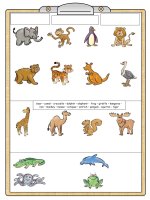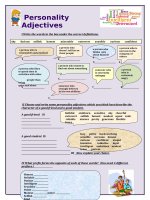ANALYSE READING B2 ANIMAL
Bạn đang xem bản rút gọn của tài liệu. Xem và tải ngay bản đầy đủ của tài liệu tại đây (6.97 MB, 30 trang )
Topic:
Animals
GROUP 1
Members: Phạm Nguyễn Thùy Trang
Trần Ngọc Thảo Vy
Dương Thị Thanh Thảo
Nguyễn Ngọc Nhã Uyên
01
Biological control of pets
02
Bring back the big cat
3 reading
1 minigame
03
Testing animal
intelligence
04
Minigame
01
Biological control of pests
Source: ĐỀ THI IELTS READING
/>
Reading 1: Biological control of pets
A.The continuous and reckless use of synthetic chemicals for the control of pests which pose a
threat to agricultural crops and human health is proving to be counter-productive. Apart from
engendering widespread ecological disorders, pesticides have contributed to the emergence of
a new breed of chemical-resistant, highly lethal superbugs.
•
Reckless use = careless use
•
Counter-productive: have the opposite effect to the one that was intended
•
Lethal: causing or able to cause death SYN: deadly, fatal
Reading 1: Biological control of pets
B. According to a recent study by the Food and Agriculture Organisation (FAO), more than 300
species of agricultural pests have developed resistance to a wide range of potent chemicals. Not to
be left behind are the disease-spreading pests, about 100 species of which have become immune
to a variety of insecticides now in use.
•
Developed resistance: able to resist something
Reading 1: Biological control of pets
C. One glaring disadvantage of pesticides' application is that, while destroying harmful pests, they also
wipe out many useful non-targeted organisms, which keep the growth of the pest population in check.
This results in what agro-ecologists call the 'treadmill syndrome'. Became of their tremendous breeding
potential and genetic diversity, many pests are known to withstand synthetic chemicals and bear
offspring with a built-in resistance to pesticides.
•
Glaring disadvantage: benefit that can easily be seen
•
In check: under control
•
Tremendous: huge
•
Bear offspring: reproduce
•
Built-in: included in something at the time that it is created
Reading 1: Biological control of pets
D. The havoc that the `treadmill syndrome' can bring about is well illustrated by what happened to cotton
farmers in Central America. In the early 1940s, basking in the glory of chemical based intensive agriculture,
the farmers avidly took to pesticides as a sure measure to boost crop yield. The insecticide was applied eight
times a year in the mid-1940s, rising to 28 in a season in the mid-1950s, following the sudden proliferation of
three new varieties of chemical-resistant pests.
•
Avidly= keenly
Reading 1: Biological control of pets
E. By the mid-1960s, the situation took an alarming turn with the outbreak of four more new pests,
necessitating pesticide spraying to such an extent that 50% of the financial outlay on cotton production was
accounted for by pesticides. In the early 1970s, the spraying frequently reached 70 times a season as the
farmers were pushed to the wall by the invasion of genetically stronger insect species.
•
Take an alarming turn with: alert
•
Push to the wall: to force someone into a position where there is only one choice to make
Reading 1: Biological control of pets
F. Most of the pesticides in the market today remain inadequately tested for properties that cause cancer
and mutations as well as for other adverse effects on health, says a study by United States environmental
agencies. The United States National Resource Defense Council has found that DDT was the most popular
of a long list of dangerous chemicals in use.
•
Adverse effects: Negative results
Reading 1: Biological control of pets
G. In the face of the escalating perils from indiscriminate applications of pesticides, a more effective and
ecologically sound strategy of biological control, involving the selective use of natural enemies of the pest
population, is fast gaining popularity — though, as yet, it is a new field with limited potential. The advantage of
biological control in contrast to other methods is that it provides a relatively low-cost, perpetual control system
with a minimum of detrimental side-effects. When handled by experts, bio-control is safe, non-polluting and
self-dispersing.
•
Escalate: to become greater, worse, more serious
•
Perpetual = Continuous
•
Side-effects: an extra and usually bad effect
•
Self-dispersing: to spread itself
Reading 1: Biological control of pets
H.The Commonwealth Institute of Biological Control (CIBC) in Bangalore, with its global
network of research laboratories and field stations, is one of the most active, noncommercial research agencies engaged in pest control by setting natural predators
against parasites. CIBC also serves as a clearing-house for the export and import of
biological agents for pest control worldwide.
•
Engage in: Take part in
Reading 1: Biological control of pets
I.
CIBC successfully used a seed-feeding weevil, native to Mexico, to control the obnoxious parthenium weed, known to exert
devious influence on agriculture and human health in both India and Australia. Similarly, the Hyderabad-based Regional
Research Laboratory (RRL), supported by CIBC, is now trying out an Argentinian weevil for the eradication of water hyacinth,
another dangerous weed, which has become a nuisance in many parts of the world. According to Mrs Kaiser Jamil of RRL, `The
Argentinian weevil does not attack any other plant and a pair of adult bugs could destroy the weed in 4-5 days.' CIBC is also
perfecting the technique for breeding parasites that prey on 'disapene scale' insects — notorious defoliants of fruit trees in the
US and India.
•
Obnoxious: Extremely unpleasant
•
Exert: to use power or influence to affect somebody/something
•
Devious: behaving in a dishonest or indirect way. SYN: deceitful, underhand
•
Notorious: well known for being bad
Reading 1: Biological control of pets
J. How effectively biological control can be pressed into service is proved by the following examples. In the late 1960s, when Sri
Lanka's flourishing coconut groves were plagued by leaf-miaing hispides, a larval parasite imported from Singapore brought the
pest under control. A natural predator indigenous to India, Neodumetia sangawani, was found useful in controlling the Rhodes
grass-scale insect that was devouring forage grass in many parts of the US. By using Neochetina bruci, a beetle native to Brazil,
scientists at Kerala Agricultural University freed a 12-kilometrelong canal from the clutches of the weed Salvinia molesta, popularly
called `African Payal' in Kerala. About 30,000 hectares of rice fields in Kerala are infested by this weed.
•
Press into service: to use something or someone that is not completely suitable because nothing or no one more suitable is
available
•
Bring sth under control: To assert control over someone or something, especially to limit their or its actions or potentially
negative effects.
02
Bring back the big cat
Source: ĐỀ THI IELTS READING
/>
Reading 2: Bring back the big cat
A. It's time to start returning vanished native animals to Britain, says John Vesty There is a poem, written around 598 AD,
which describes hunting a mystery animal called a llewyn. But what was it? Nothing seemed to fit, until 2006, when an animal
bone, dating from around the same period, was found in the Kinsey Cave in northern England. Until this discovery, the lynx - a
large spotted cat with tassel led ears - was presumed to have died out in Britain at least 6,000 years ago, before the
inhabitants of these islands took up farming. But the 2006 find, together with three others in Yorkshire and Scotland, is
compelling evidence that the lynx and the mysterious llewyn were, in fact, one and the same animal. If this is so, it would
bring forward the tassel-eared cat's estimated extinction date by roughly 5,000 years.
•
Bring forward: to change the date or time of an event so that it happens earlier than planned
•
Compelling evidence = strong evidence
Reading 2: Bring back the big cat
B. However, this is not quite the last glimpse of the animal in British culture. A 9th- century stone cross from the
Isle of Eigg shows, alongside the deer, boar and aurochs pursued by a mounted hunter, a speckled cat with
tasselled ears. Were it not for the animal's backside having worn away with time, we could have been certain, as
the lynx's stubby tail is unmistakable. But even without this key feature, it's hard to see what else the creature
could have been. The lynx is now becoming the totemic animal of a movement that is transforming British
environmentalism: rewilding.
•
Glimpse: a glance
•
Environmentalism: concern about the natural environment and how to improve and protect it
Reading 2: Bring back the big cat
C. Rewilding means the mass restoration of damaged ecosystems. It involves letting trees return to places that
have been denuded, allowing parts of the seabed to recover from trawling and dredging, permitting rivers to flow
freely again. Above all, it means bringing back missing species. One of the most striking findings of modern ecology
is that ecosystems without large predators behave in completely different ways from those that retain them Some of
them drive dynamic processes that resonate through the whole food chain, creating niches for hundreds of species
that might otherwise struggle to survive. The killers turn out to be bringers of life.
•
Denuded: to remove the covering of something, especially land
•
Striking findings: findings that are significant
•
Dynamic processes: processes that continuously change or develop
Reading 2: Bring back the big cat
D. Such findings present a big challenge to British conservation, which has often selected arbitrary assemblages
of plants and animals and sought, at great effort and expense, to prevent them from changing. It has tried to
preserve the living world as if it were a jar of pickles, letting nothing in and nothing out, keeping nature in a
state of arrested development. But ecosystems are not merely collections of species; they are also the dynamic
and ever-shifting relationships between them. And this dynamism often depends on large predators.
•
•
•
•
•
Arbitrary: not seeming to be based on a reason, system, or plan and sometimes seeming unfair
Assemblage: a collection of things; a group of people
Arrested development: the stop of development
Ever-shifting: always change
Dynamism: energy and enthusiasm to make new things happen or to make things succeed
Reading 2: Bring back the big cat
E. At sea the potential is even greater: by protecting large areas from commercial fishing, we
could once more see what 18th-century literature describes: vast shoals of fish being chased by
fin and sperm whales, within sight of the English shore. This policy would also greatly boost
catches in the surrounding seas; the fishing industry's insistence on scouring every inch of
seabed, leaving no breeding reserves, could not be more damaging to its own interests.
•
Scour: to search a place or thing carefully and completely in order to find
Reading 2: Bring back the big cat
F. The lynx presents no threat to human beings: there is no known instance of one preying on people. It is a specialist
predator of roe deer, a species that has exploded in Britain in recent decades, holding back, by intensive browsing, attempts
to re-establish forests. It will also winkle out sika deer: an exotic species that is almost impossible for human beings to
control, as it hides in impenetrable plantations of young trees. The attempt to reintroduce this predator marries well with
the aim of bringing forests back to parts of our bare and barren uplands. The lynx requires deep cover, and as such presents
little risk to sheep and other livestock, which are supposed, as a condition of farm subsidies, to be kept out of the woods.
•
Present no threat = pose no threat
•
Marries well with: to combine two different things, ideas, etc. successfully
•
Winkle out: to get or find something or someone with difficulty
Reading 2: Bring back the big cat
G. On a recent trip to the Cairngorm Mountains, I heard several conservationists suggest that the lynx could be reintroduced there
within 20 years. If trees return to the bare hills elsewhere in Britain, the big cats could soon follow. There is nothing extraordinary about
these proposals, seen from the perspective of anywhere else in Europe. The lynx has now been reintroduced to the Jura Mountains, the
Alps, the Vosges in eastern France and the Harz mountains in Germany, and has re-established itself in many more places. The European
population has tripled since 1970 to roughly 10,000. As with wolves, bears, beavers, boar, bison, moose and many other species, the
lynx has been able to spread as farming has, left the hills and people discover that it is more lucrative to protect charismatic wildlife
than to hunt it, as tourists will pay for the chance to see it. Large-scale rewilding is happening almost everywhere - except Britain.
•
Lucrative: producing a large amount of money; making a large profit
•
Charismatic wildlife: Charismatic species are usually defined as “popular, serve as symbols and rallying points to
stimulate conservation awareness and action.”
03
Testing animal intelligence
Source: IELTS READING PRACTICE TEST 7-2
/>
Reading 3: Testing animal intelligence
A. Applying human intelligence tests to animals has been largely discredited, as these are
designed to measure human intelligence. Even time-honoured tests like putting rats into
mazes can be deceptive, since such tests assume the animals will rely on the same senses as
we do. A rat's primary sense organ is its nose, not its eyes. Give a rat a maze of smells, not
just visible walls, and it can solve it as fast as a human can.
•
Discredit: cause pp to stop
•
Deceptive: making pp believe st that is not true
•
Time-honoured: to be important or respected b/c of having existed for many years
Reading 3: Testing animal intelligence
D. Animals can do things like navigating or remembering the locations of objects much
better than we can. What they don't do so well is apply reasoning to a whole range of
problems, which is one of the things that has made human beings so successful as a
species.
•
Navigate: to direct the way that a ship, aircraft,… will travel
Reading 3: Testing animal intelligence
E. Part of the problem in assessing animal intelligence is communication. For example we can't speak to
dolphins, because they can't hear human speech very well. And their own language is so different from
ours that it will take years of research and enormous computing power to decipher it. So far, scientists
have only identified the names, or 'call-signs', by which dolphins seem to refer to themselves and each
other, including talking about other dolphins who aren't present. The best we can do is to develop a
common language of signs.
•
•
Decipher: to discover sth
Call-sign: a message, code that is broadcasted by radio









